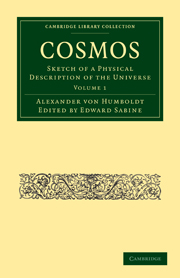II - LANDSCAPE PAINTING
from INCITEMENTS TO THE STUDY OF NATURE: General Remarks
Published online by Cambridge University Press: 05 August 2011
Summary
As fresh and vivid descriptions of natural scenes and objects are suited to enhance a love for the study of nature, so also is landscape painting. Both shew to us the external world in all its rich variety of forms, and both are capable, in various degrees, according as they are more or less happily conceived, of linking together the outward and the inward world. It is the tendency to form such links which marks the last and highest aim of representative art; but the scientific object to which these pages are devoted, restricts them to a different point of view; and landscape painting can be here considered only as it brings before us the characteristic physiognomy of different positions of the earth's surface, as it increases the longing desire for distant voyages, and as, in a manner equally instructive and agreeable, it incites to fuller intercourse with nature in her freedom.
In classical antiquity, from the peculiar direction of the Greek and Roman mind, landscape painting, like the poetic description of scenery, could scarcely become an independent object of art: both were used only as auxiliaries. Employed in complete subordination to other objects, landscape painting long served merely as a background to historical composition, or as an accidental ornament in the decoration of painted walls.
- Type
- Chapter
- Information
- CosmosSketch of a Physical Description of the Universe, pp. 74 - 91Publisher: Cambridge University PressPrint publication year: 2010First published in: 1846

